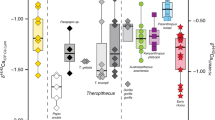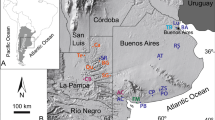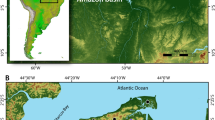Abstract
It has been suggested that a shift in diet is one of the key adaptations that distinguishes the genus Homo from earlier hominins, but recent stable isotopic analyses of fossils attributed to Homo in the Turkana Basin show an increase in the consumption of C4 resources circa 1.65 million years ago, significantly after the earliest evidence for Homo in the eastern African fossil record. These data are consistent with ingesting more C4 plants, more animal tissues of C4 herbivores, or both, but it is also possible that this change reflects factors unrelated to changes in the palaeobiology of the genus Homo. Here we use new and published carbon and oxygen isotopic data (n = 999) taken from large-bodied fossil mammals, and pedogenic carbonates in fossil soils, from East Turkana in northern Kenya to investigate the context of this change in the isotope signal within Homo. By targeting taxa and temporal intervals unrepresented or undersampled in previous analyses, we were able to conduct the first comprehensive analysis of the ecological context of hominin diet at East Turkana during a period crucial for detecting any dietary and related behavioural differences between early Homo (H. habilis and/or H. rudolfensis) and Homo erectus. Our analyses suggest that the genus Homo underwent a dietary shift (as indicated by δ13Cena and δ18Oena values) that is (1) unrelated to changes in the East Turkana vegetation community and (2) unlike patterns found in other East Turkana large mammals, including Paranthropus and Theropithecus. These data suggest that within the Turkana Basin a dietary shift occurred well after we see the first evidence of early Homo in the region.
This is a preview of subscription content, access via your institution
Access options
Access Nature and 54 other Nature Portfolio journals
Get Nature+, our best-value online-access subscription
$29.99 / 30 days
cancel any time
Subscribe to this journal
Receive 12 digital issues and online access to articles
$119.00 per year
only $9.92 per issue
Buy this article
- Purchase on Springer Link
- Instant access to full article PDF
Prices may be subject to local taxes which are calculated during checkout




Similar content being viewed by others
Data availability
All raw data associated with this work are available in supplementary datasets. Inquiries should be directed to david.patterson@ung.edu.
References
Sponheimer, M. et al. Isotopic evidence of early hominin diets. Proc. Natl Acad. Sci. USA 110, 10513–10518 (2013).
Levin, N. E. et al. Dietary change among hominins and cercopithecids in Ethiopia during the Pliocene. Proc. Natl Acad. Sci. USA 112, 12304–12309 (2015).
Cerling, T. E. et al. Stable isotope-based diet reconstructions of Turkana Basin hominins. Proc. Natl Acad. Sci. USA 110, 10501–10506 (2013).
Wood, B. A. Koobi Fora Research Project : Hominid Cranial Remains (Clarendon Press, 1991).
Wood, B. A. & Aiello, L. C. Taxonomic and functional implications of mandibular scaling in early hominins. Am. J. Phys. Anthropol. 105, 523–538 (1998).
Lepre, C. J. et al. An earlier origin for the Acheulian. Nature 477, 82–85 (2011).
Harris, J. W. K. & Isaac, G. L. The Karari Industry: Early Pleistocene archaeological evidence from the terrain, east of Lake Turkana. Nature 262, 102–107 (1976).
Rogers, M. J., Harris, J. W. K. & Feibel, C. S. Changing patterns of land use by Plio-Pleistocene hominids in the Lake Turkana Basin. J. Hum. Evol. 27, 139–158 (1994).
Ludwig, B. V. & Harris, J. W. K. In The Rise and Diversity of the Lower Paleolithic, (eds Petraglia, M. & Paddaya, K.) 84–104 (Academic Press, 1998).
Braun, D. R., Rogers, M. J., Harris, J. W. K. & Walker, S. J. Landscape-scale variation in hominin tool use: evidence from the developed Oldowan. J. Hum. Evol. 55, 1053–1063 (2008).
Braun, D. R., Harris, J. W. K. & Maina, D. N. Oldowan raw material procurement and use: evidence from the Koobi Fora Formation. Archaeometry 51, 26–42 (2009).
Wood, B. A. & Collard, M. The human genus. Nature 284, 65–71 (1999).
Antón, S. C., Potts, R. & Aiello, L. C. Evolution of early Homo: an integrated biological perspective. Science 345, 1236828 (2014).
Wood, B. A. & Leakey, M. G. The Omo-Turkana Basin fossil hominins and their contribution to our understanding of human evolution in Africa. Evol. Anth 20, 264–292 (2011).
Levin, N. E. et al. Paleosol carbonates from the Omo Group: isotopic records of local and regional environmental change in East Africa. Palaeogeogr. Palaeoclimatol. Palaeoecol. 307, 75–89 (2011).
Uno, K. et al. Late Miocene to Pliocene carbon isotope record of differential diet change among East African herbivores. Proc. Natl Acad. Sci. USA 108, 6509–6514 (2011).
Bobe, R. & Behrensmeyer, A. K. The expansion of grassland ecosystems in Africa in relation to mammalian evolution and the genus Homo. Palaeogeogr. Palaeoclimatol. Palaeoecol. 207, 399–420 (2004).
Quinn, R. L., Lepre, C. J., Wright, J. D. & Feibel, C. S. Paleogeographic variations of pedogenic carbonate δ13C values from Koobi Fora, Kenya: implications for floral compositions of Plio-Pleistocene hominin environments. J. Hum. Evol. 53, 560–573 (2007).
Brown, F. H. & McDougall, I. Geochronology of the Turkana Depression of northern Kenya and southern Ethiopia. Evol. Anthropol. 20, 217–227 (2011).
R Core Team. R: A Language and Environment For Statistical Computing (R Foundation for Statistical Computing, 2014); http://www.R-project.org/
Levin, N. E. et al. A stable isotope aridity index for terrestrial environments. Proc. Natl Acad. Sci. USA 103, 11201–11205 (2006).
Blumenthal, S. A. et al. Aridity and hominin environments. Proc. Natl Acad. Sci. USA 114, 7331–7336 (2017).
Cerling, T. E. et al. Woody cover and hominin environments in the past 6 million years. Nature 476, 51–56 (2011).
Cerling, T. E. et al. Dietary changes of large herbivores in the Turkana Basin, Kenya from 4 to 1 Ma. Proc. Natl Acad. Sci. USA 112, 11467–11472 (2015).
Patterson, D. B. et al. Ecosystem evolution and hominin paleobiology at East Turkana, northern Kenya between 2.0 and 1.4 Ma Palaeogeogr. Palaeoclimatol. Palaeoecol. 481, 1–13 (2017).
Brown, F. H. & Feibel, C. S. In Koobi Fora Research Project Vol. 3 (ed. Harris, J. M.) 1–30 (Clarendon Press, 1991).
Craig H. & Gordon L. I. in Stable Isotopes in Oceanographic Studies and Paleotemperatures (ed. Tongiorgi, E.) 9–130 (V. Lischi, 1965).
Quinn, R. L. Influence of Plio-Pleistocene basin hydrology on the Turkana hominin enamel carbonate δ18O values. J. Hum. Evol. 86, 13–31 (2015).
Jenny, H. The Soil Resource: Origin and Behavior (Springer, 1980).
Machette, M. N. Calcic soils of the southwestern United States. Geo. Soc. Am., Spec. Pap. 203, 1–21 (1985).
Retallack, G. J. Pedogenic carbonate proxies for amount and seasonality of precipitation in paleosols. Geology 33, 333–336 (2005).
Du, A. et al. Stable carbon isotopes from paleosol carbonate and herbivore enamel document differing paleovegetation signals in the eastern African Plio-Pleistocene. Rev. Palaeobot. Palynol. 261, 41–52 (2019).
Aiello, L. C. & Wheeler, P. The expensive-tissue hypothesis: The brain and the digestive system in human and primate evolution. Curr. Anthropol. 36, 199–221 (1995).
Leonard, W. R. & Robertson, M. L. Nutritional requirements and human evolution: a bioenergetics model. Am. J. Hum. Biol. 4, 179–195 (1992).
Antón, S. C. in Primate Craniofacial Function and Biology (ed. Vineyard, C. et al.) 443–482 (Springer, 2008).
Braun, D. R. et al. Early hominin diet included diverse terrestrial and aquatic animals 1.95 Ma in East Turkana, Kenya. Proc. Natl Acad. Sci. 107, 10002–10007 (2010).
Pobiner, B., Rogers, M., Monahan, C. M. & Harris, J. W. K. New evidence for hominin carcass processing strategies at 1.5 Ma, Koobi Fora, Kenya. J. Hum. Evol. 55, 103–130 (2008).
Merritt, S. R. Investigating hominin carnivory in the Okote Member of Koobi Fora, Kenya with an actualistic model of carcass consumption and traces of butchery on the elbow. J. Hum. Evol. 112, 105–133 (2017).
Merritt, S. R. et al. FwJj70—a potential Early Stone Age single carcass butchery locality preserved in a fragmentary surface assemblage. J. Arch. Sci. Rep. 20, 736–747 (2018).
Wrangham, R. W., Jones, J. H., Laden, G., Pilbeam, D. & Conklin-Brittain, N. The raw and the stolen: cooking and the ecology of human origins. Curr. Anthropol. 40, 567–594 (1999).
Paine, O. C. C. et al. Grass leaves as potential hominin dietary resources. J. Hum. Evol. 117, 44–52 (2018).
Sponheimer, M. & Lee-Thorp, J. A. Oxygen isotopes in enamel carbonate and their ecological significance. J. Arch. Sci. 26, 723–728 (1999).
Patterson, D. B. et al. Landscape scale heterogeneity in the East Turkana ecosystem during the Okote Member (1.56–1.38 Ma). J. Hum. Evol. 112, 148–161 (2017).
Acknowledgements
We thank the National Museums of Kenya for their unwavering support, and T. Cerling, N. Levin, B. Passey, M. Fortelius, M. Leakey and F. Brown for thoughtful input and analytical assistance throughout the duration of this project. We also thank M. Sponheimer, I. Zliobaite, Z. Alemseged, E. Ndiema, K. Uno, P. Kiura, M. Kibunjia, J. Sealy, J. Kingston, J. T. Faith, R. Potts, A. Du, F. Bibi, C. Tryon, J. Harris, M. Grabowski, N. Blegen, J. Patterson, K. Hatala, R. Cutts, A. Zipkin, J. Rowan, D. Leslie, A. Brooks, J. Yellen, K. Chritz, S. Blumenthal, K. Ranhorn, S. McFarlin, S. Hlubik and the NMNH Evolution of Terrestrial Ecosystems Program for helpful discussions. We acknowledge the use of imagery from the NASA Worldview application (https://worldview.earthdata.nasa.gov). This project was supported by an NSF-DDRI (1424203) and Wenner-Gren Dissertation Fieldwork Grant to D.B.P.
Author information
Authors and Affiliations
Contributions
D.B.P., R.B., A.K.B., D.R.B. and B.W. designed the research. D.B.P., R.B., A.K.B., D.R.B., K.A., W.A.B., M.B., S.B.L., T.M., F.K.M., S.R.M., S.E.M., K.O. and J.S.R. collected and analysed the data. All authors participated in the interpretation of the results and wrote the paper.
Corresponding author
Ethics declarations
Competing interests
The authors declare no competing interests.
Additional information
Publisher’s note: Springer Nature remains neutral with regard to jurisdictional claims in published maps and institutional affiliations.
Supplementary information
Supplementary Information
Supplementary Text, Supplementary References and Supplementary Figs. 1 and 2
Supplementary Dataset 1
Compilation of stable carbon isotope data from eastern African hominin taxa; see page one for raw data and page two for references
Supplementary Dataset 2
Compilation of stable carbon and oxygen isotope data from fossil mammal enamel from East Turkana dating to between 2.0 and 1.4 Ma
Supplementary Dataset 3
Compilation of stable carbon and oxygen isotope data from soil carbonates at East Turkana dating to between 2.0 and 1.4 Ma
Rights and permissions
About this article
Cite this article
Patterson, D.B., Braun, D.R., Allen, K. et al. Comparative isotopic evidence from East Turkana supports a dietary shift within the genus Homo. Nat Ecol Evol 3, 1048–1056 (2019). https://doi.org/10.1038/s41559-019-0916-0
Received:
Accepted:
Published:
Issue Date:
DOI: https://doi.org/10.1038/s41559-019-0916-0
This article is cited by
-
Why the geosciences are becoming increasingly vital to the interpretation of the human evolutionary record
Nature Ecology & Evolution (2023)
-
Investigating Isotopic Niche Space: Using rKIN for Stable Isotope Studies in Archaeology
Journal of Archaeological Method and Theory (2022)
-
Contracting eastern African C4 grasslands during the extinction of Paranthropus boisei
Scientific Reports (2021)
-
New hominin remains and revised context from the earliest Homo erectus locality in East Turkana, Kenya
Nature Communications (2021)
-
Intrataxonomic trends in herbivore enamel δ13C are decoupled from ecosystem woody cover
Nature Ecology & Evolution (2021)



